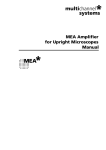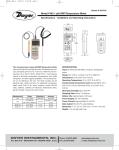Download pH electrode, round tip - GE Healthcare Life Sciences
Transcript
GE Healthcare pH electrode, round tip Instructions Important user information All users must read these entire instructions to fully understand the safe use of the pH electrode. WARNING! The Warning sign highlights an instruction that must be strictly followed in order to avoid personal injury. Be sure not to proceed until the instructions are clearly understood and all stated conditions are met. Caution! The Caution sign is used to call attention to instructions or conditions that must be followed to avoid damage to the product or other equipment. Be sure not to proceed until the instructions are clearly understood and all stated conditions are met. Note The Note sign is used to indicate information important for trouble-free and optimal use of the product. Contents 2 Introduction 3 Installation 3 Operation 5 Maintenance 6 Trouble shooting 7 Reference information 7 Instructions 56-3093-41 Edition AE Introduction The GE Healthcare pH electrode, round tip, is optimized for continuous pH measurement in a liquid chromatography system. For best performance the pH electrode and flow cell shall be used together with pH monitors from GE Healthcare or other high input impedance pH monitors. This instruction describes pH electrode, round tip (code no. 18-1111-26) and pH electrode, round tip, complete, (code no. 18-1134-84), and how to use them. The complete electrode also includes flow cell and flow cell holder. Safety WARNING! When using hazardous chemicals, suitable protective measures, such as protective glasses and gloves resistant to the chemicals used. Follow local regulations and instructions for safe operation and maintenance of the system. Installation Unpacking Unpack the electrode and check the items against the packing list. Inspect the items for obvious damage which may have occurred during transport. Note: Handle the pH electrode with care. Installing the pH electrode The pH electrode is easily connected to any GE Healthcare liquid chromatography system. The flow cell has UNF 10-32 2B connections. If pre-flanged tubing with M6 connectors is used in the system, use the union M6 female/1/16" male supplied to connect the flow cell to the system. CAUTION! The tip of the pH electrode consists of a thin glass membrane. Protect it from breakage, contamination and drying out or the electrode will be destroyed. The electrode is delivered in a plastic bottle containing a 1:1 mixture of pH 4 buffer and 1M KNO3. Always store the electrode in this solution. Do not store in water only. Instructions 56-3093-41 Edition AE 3 1 Remove the electrode end cover, in which the electrode is delivered. Ensure that the electrode is not broken or dry. 2 Prior to first using the electrode, immerse the glass tip in buffer solution pH 4 for 30 minutes. 3 Carefully insert the electrode in the flow cell. Fasten the locking nut by hand to secure the electrode. Note: If the electrode is not fully inserted, the system will leak and a dead volume will occur in the holder. To instrument Electrode Nut Flow cell Inlet/outlet tubings 4 Connect the inlet tubing to one of the ports of the flow cell (either port can be used). 5 Connect an outlet tubing to the other port on the flow cell. Note: The outlet should always be positioned higher than the inlet to reduce the risk of air bubbles getting trapped in the flow cell. 6 Connect the pH electrode cable to the pH monitor. Preparing the pH electrode for use Before the pH electrode is ready to be used, the pH monitor must be calibrated. Please refer to section 3. Note: When running chromatography using organic solvent, we recommend that the pH electrode is removed, as organic solvents will cause pH electrode degeneration. 4 Instructions 56-3093-41 Edition AE Operation Calibration It is always necessary to calibrate a pH monitor with the pH electrode to be used to adapt the pH monitor to the characteristics of the electrode. A good laboratory routine is to calibrate the instrument once a day, when the electrode is replaced and if the ambient temperature is changed. Calibration of the pH monitor can be done with the pH electrode either fitted in or removed from the flow cell. A pH monitor is calibrated using standard buffer solutions in a two point calibration. The two buffer solutions can have any pH value as long as the difference between them is at least 1 pH unit. Calibration of GE Healthcares pH monitor Calibrating with the electrode outside the flow cell When calibrating the electrode out of the flow cell and changing from one buffer to another, rinse the electrode tip with distilled water and dab it carefully with a soft tissue to absorb the remaining water. Do NOT wipe the electrode as this may charge it and give unstable readings. The steps below describe the procedure used with the electrode removed from the flow cell. 1 Remove the pH electrode from the flow cell and immerse the electrode in the 1:st standard buffer solution (normally pH 7.0) 2 Allow the pH monitor to stabilize. Adjust it to the pH of the buffer using the potentiometer ZERO on the pH monitor. 3 Rinse the electrode tip with distilled water and then immerse the electrode in the 2:nd standard buffer solution (e.g. 4.0 or 9.0). 4 Allow the pH monitor to stabilize and then adjust the reading to the pH of the calibration buffer using the potentiometer SLOPE. 5 The instrument is now calibrated and ready for use. Calibrating with the electrode in the flow cell When calibrating with the electrode fitted in the flow cell, follow the above procedure but let at least 5 ml of standard buffer solution be pumped through the flow cell to reach equilibrium before adjusting the pH monitor. Calibration of pH monitors in ÄKTAdesign systems Calibrating pH monitors in ÄKTA™design systems is desbribed in section 6.6 in UNICORN™ User Manual. Calibration of Monitor pH/C-900 or Monitor UPC-900 when used as stand-alone Please refer to respective User Manual. Instructions 56-3093-41 Edition AE 5 Storage The pH electrode should always be stored in a 1:1 mixture of pH 4 buffer and 1 M KNO3 when not in use. If the electrode is used infrequently, the plastic end cover, in which the electrode is supplied, can be used to store the electrode. Electrode regeneration If the electrode has dried out, immerse the lower end of the electrode in a 1:1 mixture of pH 4 buffer and 1 M KNO3 overnight. Maintenance Periodic maintenance Period Action Every 6 months or more often if required Change pH electrode When required Clean the pH electrode Cleaning the pH electrode Note: The pH electrode has a limited life length and should be replaced every six month or when the response time is slow. To improve the response, clean the electrode using one of the following procedures: – Salt deposits: Dissolve the deposit byimmersing the electrode in: – 0.1 M HCl – 0.1 M NaOH – 0.1 M HCl each for five minutes. Rinse electrode tip in distilled water between each solution. – Oil or grease films: Wash the electrode tip in liquid detergent and water. If films are known to be soluble in a particular organic solvent, wash with this solvent. Rinse electrode tip in distilled water. – Protein deposits: Dissolve the deposit by immersing the electrode in a 1% pepsin solution, in 0.1 M HCl, for five minutes followed by thorough rinsing with distilled water. If these procedures fail to rejuvenate the electrode, try the following procedure: 1 Heat a 1 M KNO3 solution to 60–80 °C. 2 Place the electrode tip in the heated KNO3 solution. 3 Allow the electrode to cool while immersedin the KNO3 solution before re-testing. If these steps fail to improve the electrode, replace the electrode. 6 Instructions 56-3093-41 Edition AE Trouble shooting Fault Action No response to pH changes 1 Check that the electrode cable is connected properly to the rear ofthe instrument. 2 The electrode glass membrane may be cracked. Replace the electrode. Small response to pH changes 1 Slow pH response or calibration impossible Clean the pH electrode according to section 4 and recalibrate. 2 If problem remains, replace the electrode. 1 Check the pH eletrode tip. If it is contaminated, clean the electrodeas described in section 4. 2 If the electrode has dried out, the electrode may be restored by soaking it in buffer overnight, as described in section 3. Incorrect/unstable pH reading 1 Check that the electrode cable is connected properly to the rear of the instrument. 2 Check that the pump and valves operate correctly. 3 Check that the electrode iscorrectly inserted in the flow celland, if necessary, hand-tighten the locking nut. 4 If air in the flow cell is suspected, tap the flow cell carefully or tilt it to remove the air. Alternatively flush the flow cell with buffer at 8 ml/min for30 seconds. 5 Check that the pH electrode is not broken. 6 Check that the pH electrode is calibrated. 7 Clean the pH electrode if required, see section 4. 8 Compare the response of the pH electrode with that of another pH electrode. If the responses differ greatly, the electrode may require cleaning or replacement. 9 There may be interference from other equipment; increase capillary length or shut off the equipment. 10 Check that the pH electrode has been calibrated at the correct temperature. 11 In organic solvents such as ethanol, methanol or acetonitrile, stable pH measurements are not possible since dehydration of the electrode will occur. It is recommended that the pH electrode is not used in applications using organic solvents. pH values vary with varied back pressure Replace the pH electrode. Reference information Sealing Internal electrolyte bridge containing 4M KCl saturated with AgCl Silicone sealing The pH electrode is of the sealed combination double junction type. It contains a sealed Ag/AgCl reference, which cannot be refilled, an internal electrolyte bridge of 4M KCl saturated with Ag/AgCl, an outer electrolyte bridge of 1M KNO3, an annular ceramic reference junction and a low profile pH membrane. The pH electrode is delivered with a transparent cover. Ag/AgCl reference electrode Internal annular coaxial ceramic reference junction The flow cell should not be used with any other flow cell. External electrolyte bridge containing 1M KNO3 O-ring Technical specifications Glass electrode containing diluted, buffered KCl O-ring External annular coaxial ceramic reference junction pH measurement pH range 0 to 14 (spec. valid between 2 and 12) Accuracy ± 0.1 pH within +4 to +40 °C Response time Max. 10 s (0–95% of step) Long term drift Max. 0.1 pH units/10 h Flow rate sensitivity Max 0.1 pH within 0–100 ml/min Instructions 56-3093-41 Edition AE 7 pH flow cell Max flow rate 100 ml/min Max pressure 0.5 MPa (5 bar, 72 psi) Back pressure Max 0.02 MPa (0.2 bar, 2.9 psi) Internal volume 88 μl Wetted materials pH electrode; Glass Flow cell: titanium and FFKM (perfluororubber) Chemical resistance The wetted parts are resistant to organic solvents and salt buffers commonly used in liquid chromatography except 100% Ethyl acetate, 100% Hexane and 100% Tetrahydrofuran (THF) Accessories and spare parts CAUTION! Only spare parts approved or supplied by GE Healthcare may be used for maintaining and servicing. Item Quantity per pack Code no. pH electrode, round tip, complete (incl. electrode, flow cell and flow cell holder 1 18-1134-84 pH electrode, round tip (incl. electrode) 1 18-1111-26 pH flow cell, round tip 1 18-1112-92 Dummy electrode, round tip 1 18-1111-03 Union M6 female/1/16" male 8 18-1112-58 Fingertight connector 1/16" 10 18-1112-55 www.gehealthcare.com GE Healthcare Europe GmbH Munzinger Strasse 5, D-79111 Freiburg, Germany GE Healthcare Bio-Sciences AB Björkgatan 30 751 84 Uppsala Sweden GE Healthcare UK Ltd Amersham Place, Little Chalfont, Buckinghamshire, HP7 9NA, UK GE Healthcare Bio-Sciences Corp 800 Centennial Avenue, P.O. Box 1327, Piscataway, NJ 08855-1327, USA GE Healthcare Bio-Sciences KK Sanken Bldg., 3-25-1, Hyakunincho, Shinjuku-ku, Tokyo 169-0073, Japan ÄKTA, UNICORN and Drop Design, are trademarks of GE Healthcare companies. GE and GE monogram are trademarks of General Electric Company. All goods and services are sold subject to the terms and conditions of sale of the company within GE Healthcare which supplies them. GE Healthcare reserves the right, subject to any regulatory and contractual approval, if required, to make changes in specifications and features shown herein, or discontinue the product described at any time without notice or obligation. Contact your local GE Healthcare representative for the most current information. © 2006 General Electric Company – All rights reserved. Elanders Tofters 2006 GE Healthcare Bio-Sciences AB, a General Electric Company. 56-3093-41 AE 02/2006





















